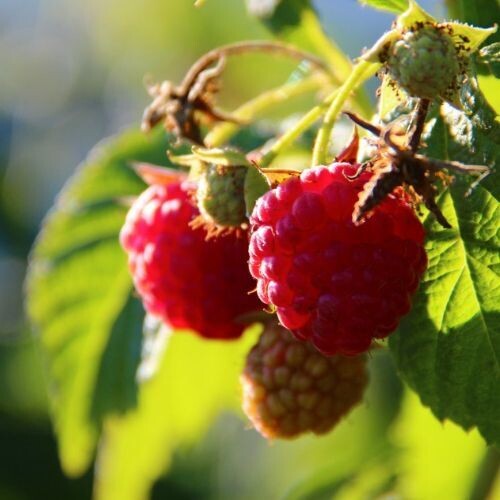RASPBERRY LEAF (Rubus idaeus) *Organic herb for horses - hormone-balancing, womb-nurturing, cycle-soothing leaf love
Benefits of Raspberry Leaf for Horses
Renowned for its uterine-toning powers, raspberry leaf is a classic reproductive herb with digestive, respiratory, and nutritive benefits. A gentle astringent, it helps soothe spasms, balance hormones, and nourishes from the inside out.
Please note this is a nutritional, functional horse food supplement and not veterinary medicine.
For more on this, see Dr Kellon's Horse Sense - Nutrition is not 'Alternative' Therapy
.

Find Raspberry Leaf in the EquiNatural range
It probably won’t come as any surprise that we blend raspberry leaf into our MellowMare , natural organic hormone harmony for calmer, happier mares.
💧Organic Raspberry Leaf Tincture
Our human-grade, certified organic tinctures give you a ready-to-absorb potent source of phytonutrients at the highest-strength available, for immediate absorption straight into the bloodstream and to the body’s cells.
- Rubus idaeus (Raspberry)
- Leaf
- Infused 1:3 25%
- Fresh Organic
~ Feed Guide - raspberry leaf tincture for horses
- 6ml/100kg bodyweight, daily in feed.
- ♻️ Our tinctures come in a heat-sealed, twin-neck, child-resistant HDPE plastic dosing bottle, complete with dosing chamber. *HDPE (High-Density Polyethylene) plastic is 100% recyclable, and energy-efficient to produce. Safe for food/water storage, it reduces waste and emissions while resisting wear. A top sustainable choice to match the EquiNatural ethos.
🌿Organic Dried Raspberry Leaf
Grown, harvested and dried without the use of agri-chemicals, non-irradiated and GMO free - see our Quality page for Quality Management & Certification Documents.
- Rubus idaeus (Raspberry)
- Leaf
- Fairwild
- Origin Poland
~ Feed Guide - dried raspberry leaf for horses
- 5g/100kg bodyweight per day, i.e. 25g for a 500kg horse.
- Want a scoop? You can add a scoop to your basket during checkout.
- ♻️Supplied in a 100% fully recylable, resealable, food-grade foil pouch for freshness.
Footnotes
- Laboratory tested for identification and compliance to the British and European Pharmacopoeia standards.
- Human grade.
- Please be aware that if you're purchasing our dried botanicals for human use, our dried range is cut to appropriate sizes for feeding to horses.
- ♻️ Eco Note: Our packaging is recyclable and refillable.
- 🧊 Storage Tip: Keep cool and dry.
Functional Nutritional Value
Constituents: Tannins (gallotannins, ellagic acid), flavonoids (kaempferol, kaempferol glycosides, quercetin, quercetin glycosides, hyperoside), phenolic acids (caffeic acid, chlorogenic acid), terpenoids (terpinolene, 3-oxo-α-ionol, a-amyrin, β-amyrin, squalene, cycloartenol), alkaloids (fragarine), volatile oils, vitamins (C, B, E), and minerals (calcium, iron, phosphorus, potassium, magnesium, manganese, zinc).
Clinical Considerations
Advisories
- Well tolerated in most horses when used at standard levels to support the mare’s cycle and muscle tone.
- Contains tannins that can have a drying, astringent effect - beneficial for firming stool and uterine tone, but best avoided in horses with very dry constitutions or active ulceration.
- Gentle uterine tonic- appropriate for cyclical balance and postpartum recovery under professional guidance.
Contraindications
- Pregnant or nursing mares: avoid in early pregnancy due to mild uterotonic activity; may be considered safe in final gestational weeks under veterinary advice.
- Anaemia: high tannin content may reduce iron absorption - use with caution or alternate days in iron-deficient horses.
- Gastrointestinal inflammation or ulceration: avoid high doses, as tannins may further irritate sensitive mucosa.
Raspberry Leaf in History & Tradition
Long before it became the herb of choice for mares and mothers alike, raspberry leaf was woven into stories of gods and healing. Greek myth tells of a nymph, Ida, who stained the berries red with her blood while picking them for baby Zeus - hence the name Rubus idaeus. Whether or not Ida was real, the reverence for raspberry certainly is.
For thousands of years, raspberry leaf has been trusted by traditional herbalists across cultures - from Dioscorides and the Cherokee, to Culpeper and the Cree. And today, it remains one of the most prized herbs in both human and equine reproductive support.
Its standout feature is fragarine , an alkaloid thought to tone and regulate the uterus - promoting smoother contractions and steadier hormone flow. But raspberry leaf is more than just a womb whisperer. Its tannins lend a gentle astringency that helps calm loose droppings, soothe diarrhoea, and reduce mucosal excess in the lungs or gut.
It’s an antispasmodic and anti-emetic, settling colic and queasiness alike. And it’s a nutrient powerhouse, offering up a buffet of vitamins and minerals - especially useful during pregnancy and recovery.
For our horses, raspberry leaf is best known as a go-to mare support herb- to ease the physical intensity of seasons, help manage behavioural changes, and provide uterine tone before and after foaling. It’s also said to help with milk production, making it a valuable ally throughout the entire reproductive cycle.
But the story doesn’t end with mares. Its traditional use for respiratory inflammation and eye complaints(hence its ‘eye berry’ nickname in Cree) also make it a versatile choice for overall health.
A quiet achiever, raspberry leaf is grounding, balancing, and deeply supportive - and not just for mares, but for the whole herd.
Copyright Notice
© EquiNatural 2025. All content is original work protected under copyright, and may not be re-published, duplicated, or rewritten for commercial use without permission.


